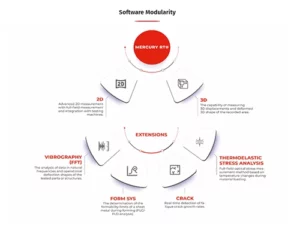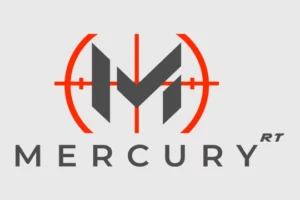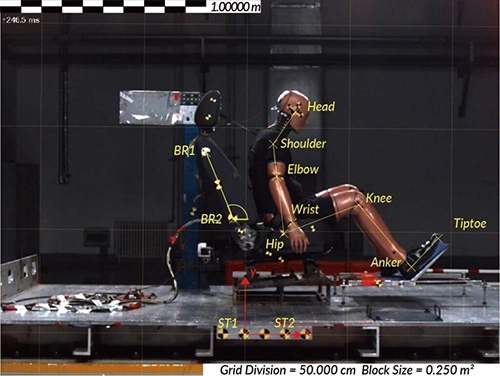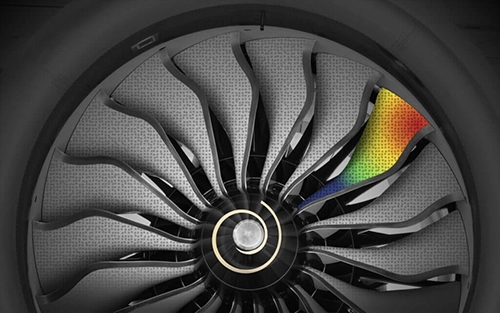Overview
Mercury RT is an advanced modular software system designed to meet the comprehensive testing and analysis needs of various industries including civil engineering, railways, shipbuilding, mining, automotive, aerospace, and defense. This system offers a range of functionalities, from structural integrity analysis and vibration monitoring to crack detection and material property assessment. By utilizing state-of-the-art 2D, 3D, Crack, Vibrography, and FormSys modules, Mercury RT® ensures precise and reliable results, enhancing the performance and safety of critical applications.
Key Features:
- Material Testing: Includes 2D/3D video extensometer, crack propagation measurement, high-temperature measurement, and fatigue tests.
- Component Testing: Offers static, dynamic measurement, high-speed camera integration, kinematic analysis, and thermomechanical testing.
- Vibration Analysis: Provides video stroboscopy, modal vibration testing, and operational deflection shape measurement.
- Software Modularity: Includes modules like RT for data acquisition, ENTER for post-processing, PLUS for enhanced capabilities, 3D Video for stereoscopic analysis, FULLFIELD for field deformation analysis, Vibrography for vibro-diagnostic measurements, and FormSys for sheet metal formability.
Highlights
- Civil Engineering:
- Detect deflection and bending stresses in roof beams
- Evaluate structural integrity and deformation in cranes
- Monitor deformation and vibration in bridge constructions
- Assess displacement field and local strains in riveted joints
- Identify material properties in timber
- Analyze crack propagation and stress distribution in concrete structures
- Evaluate load-bearing capacity and stability in building statics
- Railways:
- Investigate wear and fatigue in rails
- Assess quality and fatigue life of welded joints
- Analyze performance and wear of suspension and brakes
- Study vibration, stress, and strain distributions in transmissions and engines
- Monitor deformation and stresses in power line poles
- Shipbuilding:
- Evaluate weld quality and fatigue behavior
- Analyze contact stress and wear in gearing
- Study hydrodynamic performance and structural integrity of propellers
- Assess stress distribution and fatigue life in anchor chains
- Investigate load capacity and structural stability in loading systems and cranes
- Analyze stress distribution in rivets shearing
- Study elasticity and fatigue life in ropes
- Mining Industry:
- Evaluate structural integrity and wear in drilling rigs
- Assess suspension and chassis deformation in transporters
- Analyze impact forces and vibration effects in jackhammers
- Investigate tool wear and surface quality in sharpening tools
- Automotive:
- Study driveline components under various load conditions
- Assess strength and fatigue life of welded joints
- Evaluate vehicle body rigidity under cornering and torsional loads
- Analyze performance and wear in engines, clutches, brakes, and transmissions
- Aerospace:
- Monitor wing deformation under various load conditions
- Assess quality and fatigue life of joints
- Evaluate deformation and stresses in fuselage under pressure changes
- Detect leaks and assess integrity of hydraulic components
- Analyze stress distribution and fatigue in jet-engine components
- Military:
- Evaluate effectiveness of helmets and body armor under impact
- Assess structural integrity and fatigue life in firearms and cannons
- Study deformation and stress propagation in structures and vehicles under blast loading
- Investigate deformation and failure mechanisms in transparent armor under ballistic impact
- Analyze performance and durability in military vehicle suspension and drivetrain components
Applications
- Civil Engineering: Evaluates structural integrity, deformation, and load-bearing capacity. 2D, 3D, Crack, and Vibrography modules.
- Railways: Investigates wear, fatigue, and stress distribution in rails and welded joints. 2D, 3D, Crack, and Vibrography modules.
- Shipbuilding: Analyzes weld quality, contact stress, and structural integrity of components like propellers and anchor chains. 2D, 3D, Crack, and Vibrography modules.
- Mining: Evaluates structural integrity and wear in drilling rigs and transporters. 2D, 3D, Crack, and Vibrography modules.
- Automotive: Assesses driveline components, welding quality, and vehicle body rigidity. 2D, 3D, Crack, Vibrography, and FormSys modules.
- Aerospace: Monitors wing deformation, joint quality, and fuselage stress under pressure changes. 2D, 3D, Crack, Vibrography, and FormSys modules.
- Defense: Tests impact resistance of helmets and body armor, blast loading on structures, and ballistic impact on transparent armor. 2D, 3D, Crack, and Vibrography modules, with specific modules tailored to different testing needs






